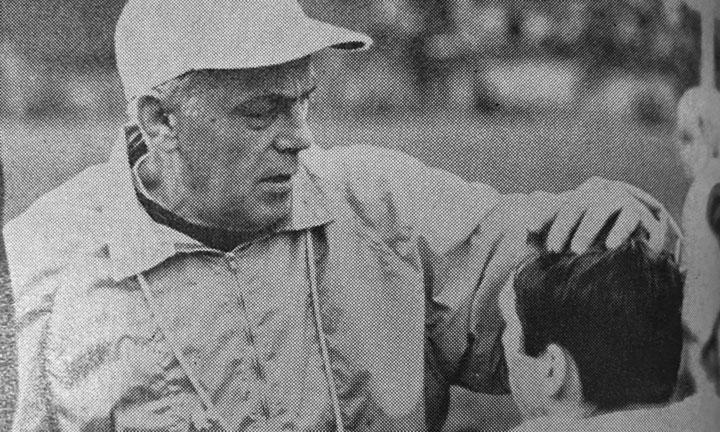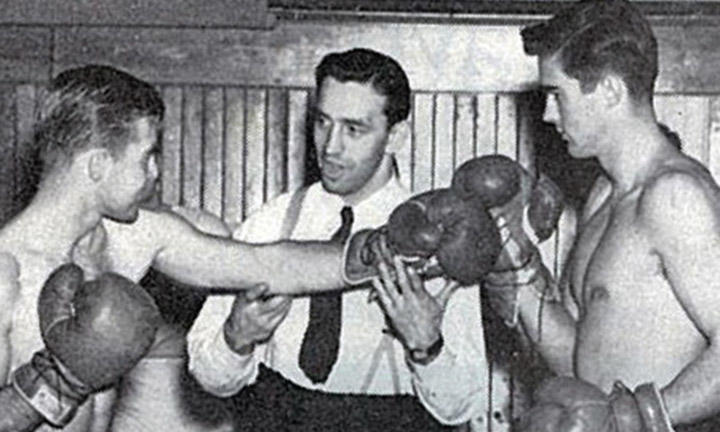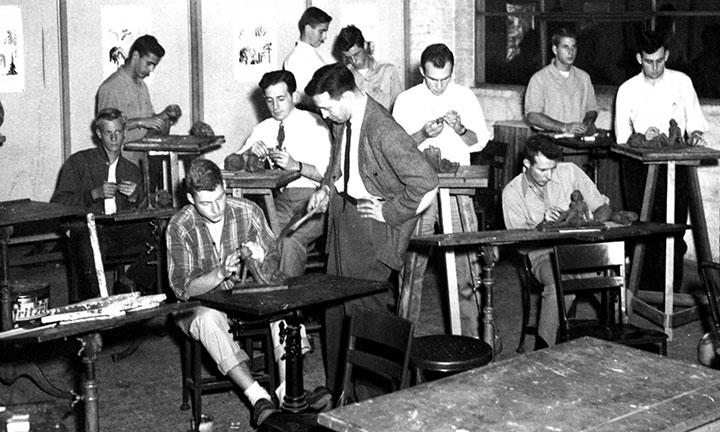“Nothing that is worth knowing can be taught.”
— Oscar Wilde
In November, we examined the ongoing unveiling of newly commissioned portraits around the campus, not as a news event but as a vehicle to consider Alan Turing *38, who triumphed at Princeton and Bletchley Park, only to fatally run afoul of 1950s social mores. It was my contention that Turing’s backstory leapt from the canvas, revealing huge forces of the 20th century that went far beyond the portrait’s subject.
In the arbitrary way history unfolds to keep us all humble, that portrait of Turing and its fellows have not been the Princeton artworks subsequently enjoying national attention. The spotlight has shifted to the series of wonderful paintings by Hodder Fellow Mario Moore honoring blue-collar staff workers at Princeton – not only depicting their daily activities and personalities, but conveying the truism that they very much are the place. As with many feel-good news stories, the heartwarming and sincere aspects of these works cover a more ambiguous layer of insight: If workers such as these were suitably regarded in the normal course of things, this wouldn’t be a news story. In any case, I will say that as much as I like all of Moore’s new pieces, the one that speaks volumes to me is that of the facilities department’s Clyde Huntley, with so many rich textures and foci.
This raises an important point, embodying a deceptively simple question for each of us. During your time at Princeton, who was the most important person to support and influence you? Oh sure, it may have been your classics professor who taught you to do truly original research and compose the thesis that paved the way to summa cum laude, but it’s also possible that martinet professor left you in tears twice a week for a year, and without the kitchen manager at your club to give you a cookie and keep you away from the cutlery, you would have come to a far different end.
On that basis we not only review Moore’s paintings in a richer light, but also open our history coffers on some of the more interesting characters around campus whose modest positions belied their influence on generations of students (by definition on campus at a vulnerable stage), often in need of some magical mix of stern wisdom and friendship. We have noted one recently: Jimmy Johnson, an ex-slave whose little 19th-century snack stand near what is now East Pyne was actually a prototype psychiatrist’s couch for all who came by. His effect on students was such that alumni paid for his funeral and interment in Princeton Cemetery when he died.
There are other unexpected Princetonians within living memory whose effect was as outsized, and today we reflect on two of them.
Joe Brown and Eddie Zanfrini both came from boxing, the working-class sporting environment of the beginning of the 20th century, Brown born in 1900 in Philadelphia, Zanfrini up the road in 1903, growing up in urban Union City, N.J. Both had elder brothers in boxing, so in a sense they joined the family business. Brown had further motivation: He was the only Jewish kid in the neighborhood, so he had to learn to fight or die in the spirit of Johnny Cash’s Boy Named Sue.E.Z. (as Zanfrini’s fans called him — he seemed to have no detractors) was a practical and clever sort. His self-evaluation of his skills as an amateur boxer led him quickly into the ranks of trainer/managers, where he became fascinated with the detailed workings of the human body. On his way to another job interview (a rarity in 1933) he stopped by Princeton on a flier and pitched head of athletics Asa Bushnell 1921 on his athletic training talents, consisting solely of boxing; recall, Princeton was big-time in sports, about to win two national football championships in the span of three years under Fritz Crisler. Dr. Harry McPhee, the young new team physician, was brought in for an added interview, and E.Z. had a job. Not one to waste an opportunity, he proceeded to work his way through McPhee’s personal library in the old University Gym until it burned down in 1940. By that time E.Z. was already the head trainer for the athletic department.
Although initially successful as an amateur boxer, Brown had other goals in life, and he managed to get a football scholarship to Temple University. That gave him a start on his college studies for two years, but when he quit to become captain of the boxing team, he had to scramble for funds. In addition to boxing, he posed as a model for art classes and became so intrigued with how bad many of the students were, he tried it himself. He became enamored of sculpture; after getting his bachelor’s degree in 1931, he became an apprentice to realist Philadelphia sculptor R. Tait Mackenzie (oddly, also the director of athletics at Penn), while on the side developing a program of instruction for beginning boxers. In 1937, he read about the death of Princeton’s intramural boxing coach and trotted up to pitch new athletics director Ken Fairman ’34 on hiring him as a replacement, which Fairman didn’t particularly want. Boxing at Princeton, aside from having negative cachet in the social scheme of things, only existed as a tribute to the concept of the manly art of self-defense (i.e. the idea that a gentleman must, when challenged nobly, fight his own battles—sort of a non-lethal echo of dueling, or chivalry, or something).
A demonstration of the curriculum Brown had been working on, in contrast, showed it to be an athletic art form, worthy of some respect. He was hired, never mentioning he was a sculptor for fear of muddying the waters. Then, in outlandish coincidence, the Carnegie Corporation in 1939 funded a five-year program to give students opportunities in the creative arts, music composition, painting, sculpture, and writing. Spearheaded by the ever-creative Dean Christian Gauss, it included Joe Brown surprisingly teaching beginning and advanced sculpture classes in the basement of Joseph Henry House, Gauss’s home on campus. The inclusion of live nude female models made it an instant hit.After the war, Zanfrini began a system of rotating trainers among the sports so they each could broaden their skills. He haunted the corridors and operating rooms of Bellevue Hospital in New York each summer to learn as much about physiology and injuries as possible; years later someone finally realized his supposed “internship” was illusory. He was head trainer of many U.S. Olympic and Pan American teams in the ’50s and ’60s. He was the first trainer to speak to the National Football Clinic and voted into the Helms Foundation College Football Hall of Fame. Most important, he dedicated himself to the student-athletes in his care, not only binding their hurts but offering a shoulder to lean on; they opened up to him as they never would to a coach who could shut them down. He became known as the conscience of Princeton football, and as Hall of Fame coach Dick Colman said, “had a better finger on the pulse of a team’s morale than any coach could possibly have.”
Zanfrini was godfather to children of many athletes including Pepper Constable ’36 and Dick Kazmaier ’52. Speaking of which, it was E.Z. who placed basketball jersey No. 42 — Kazmaier’s number — into Bill Bradley ’65’s freshman locker in 1961. The rest is history.
Brown received tenure in 1952, built enrollment in the boxing club as high as 200 or so before it inevitably faded with the advent of multitudinous options, ending in 1962. But his sculpture classes proliferated, expanding to larger space at 185 Nassau Street in 1966, earning course credit and increasing respect on campus. His dozens of sculptures, most of athletes but including other notable figures such as Leadbelly, Robert Frost, and Norman Thomas 1905, were commissioned and acquired by an ever-widening range of institutions, from the Pennsylvania Academy of Fine Arts, where he had posed to earn money for college, to Philadelphia’s Veterans Stadium, which commissioned four huge athletic statues that stood around its perimeter.Princeton owns 17 of Brown’s works, including my favorites, “Passing Baton/Receiving Baton,” in the Dillon Gym lobby, composed of metal from the dozens of trophies melted in the University Gym fire of 1940 that claimed Dr. McPhee’s books. Brown was the boxing coach for 25 years and professor of sculpture for 37 — a descriptive sentence you will never see in reference to another living person.
And so when E.Z. retired in 1968, the University commissioned Professor Brown to sculpt him. The evocative bronze now graces the Zanfrini Lounge on the C Floor of Jadwin Gym. It’s a typical sideline pose until you look at the knowing hands. Are they a trainer/masseur’s hands? A sculptor’s hands? A painter’s hands? A facilities’ worker’s hands?
Yes, I do believe they are.














2 Responses
Richard Hokin ’62
5 Years AgoMemories of Joe Brown
I have fond memories of Joe Brown (Rally ’Round the Cannon, published online Feb. 28). Freshman phys. ed. offered boxing, which struck me as an attractive alternative to the standard offering. On the class’ first day, Joe’s introduction was, “If you’re here to learn the manly art of self-defense, you’re in the wrong place. Boxing isn’t manly, it’s not an art, and it’s a lousy way to defend yourself.”
Looking back on Joe’s teaching of boxing technique, I’d dispute his opinion of the art part, but given his propensity to match me up with sparring partners whose reach always exceeded mine, I would agree fully on the self-defense part. Nonetheless, what I learned from Joe’s boxing class left me with lifelong appreciation and envy of Sugar Ray Robinson. I also recall that one of my roommates blessed with a more Adonis-like physique than I modeled for Joe’s sculpture class.
Robert P. Mack, M.D. ’57
5 Years AgoInspired by E.Z. and Doc McPhee
I have many fond memories of E.Z. As a JV football player for four years (captain senior year), I spent considerable time under the healing hands of E.Z. He was inspirational.
Doc McPhee had a direct stimulus on my interest in medicine and its relationship to athletic injuries. He demonstrated to me how a physician can relate to athletes and care for their injuries. This led to my career in orthopaedic surgery and my induction into the American Orthopaedic Society for Sports Medicine Hall of Fame in 2010. I am indebted to both men for their early influence on my career.